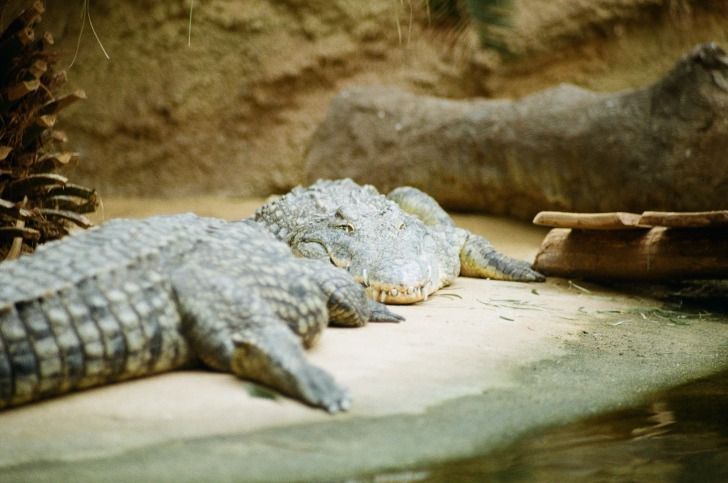Chinese alligators are a longstanding fixture in Chinese culture and literature.
They have been mentioned since at least the third century AD.
Marco Polo was the first person from outside China to write about these animals, in the late 1200s.
Chinese alligators are often associated with the Chinese dragon and may have served as inspiration for the mythical beast.
But just what are Chinese alligators and what makes them so special?
Contents
So… Are There Alligators in China?
There are one species of alligator in China: the Chinese alligator also called the China or Yangtze alligator.
Historically, it was also known as the muddy dragon.
This crocodilian species is endemic to China but its range once spread much farther.
It is one of only two living species in the Alligator genus, in the family Alligatoridae.
Chinese alligators are darker in color than their American cousins.
They are typically very dark gray, even black.
Their bodies are fully armored in tight, thick scales.
Adult specimens can grow to seven feet (a little over two meters) in length, weighing up to 100 pounds (45 kilograms).
This species is unlike the American alligator in a number of ways.
Chinese alligators brumate during the winter, burrowing in holes to wait for better weather.
During warm months, the Chinese alligator lives nocturnally.
This helps it avoid interacting with humans, who historically have been its greatest threat.
This species has been recorded to live up to 70 years in captivity.
Wild specimens are known to live at least 50 years.
The Chinese alligator mates in the summer.
Females typically lay between 20 and 30 eggs per clutch, less than other crocodilian species.
The Yangtze alligator is an opportunistic predator that mostly consumes fish and marine invertebrates.
While this species is quite vocal generally, they become especially communicative during mating season.
Adults bellow back and forth to each other.
Young alligators communicate with their parents and each other, as well.
Yangtze alligators live in freshwater bodies in six regions of the Anhui province.
This is their only remaining natural habitat.
Chinese alligators were once found as far from Anhui as Japan with a wide population range.
By about 5000 BC, habitat destruction and other human-caused threats began its decline.
By the 1970s, this once sprawling species had been reduced to about 1,000 wild individuals.
By 2001, this number had fallen below even 130. It wasn’t until 2003 that the population began to grow once again.
As of 2017, the wild population is at least 300 individuals, and conservation work continues apace.

Alligator Species in China
Chinese or Yangtze alligators are the only alligator species in China.
The Yangtze alligator now lives in a single small region of northeastern China.
These smaller alligators are the most endangered member of the crocodilian family.
There are only as few as 150 to 300 individuals known in the wild.
Because of this, Chinese alligators are listed as Critically Endangered on the IUCN Red List.
Established breeding programs have been working to save the Chinese alligator for decades.
Consequently, there are now anywhere from 10,000 to 20,000 individuals in captivity around the world.
While their population rebound has been slow in coming, it has proceeded on an upward trend since just after the turn of the century.
Is it Safe to Swim in China?
Because the species is so close to extinction in the wild, it’s unlikely you’ll ever bump into one.
The population is a mere few hundred individuals.
But even should you, there’s little cause for concern.
Chinese alligators are the least aggressive species in the order of Crocodylia.
These docile reptiles intentionally avoid human interaction whenever possible.
Jellyfish — Animals besides the Chinese alligator can pose dangers.
Jellyfish are sometimes a nuisance on Chinese beaches like any other.
Jellyfish numbers change day-to-day with climate and tidal fluctuations.
Thankfully, these are usually not numerous enough to be an issue for swimmers.
Swimmers rarely encounter even one.
Sea Urchins — Sea urchins are an important consideration since they’re commonly found around rocky areas along coasts.
Wearing aqua socks or shoes is recommended if you’ll spend time in these areas.
Riptides — Other potential hazards exist when considering whether it is safe to swim in China.
Like anywhere else, beaches can be host to strong riptides and undercurrents.
Thankfully, this is not as common on most beaches, especially the most popular ones.
Nevertheless, be sure to check local conditions before swimming.
Like any other coast, Chinese beaches can get storms and hurricanes, or typhoons.
These are rare and there is almost always ample warning.
Interesting Alligator Facts in China
Chinese alligators have numerous unique behavioral and physical traits.
They are quite different from other crocodilians and their closest living relative, the American alligator.
Chinese alligators are quite timid and docile, avoiding humans if possible.
This species digs major tunnel networks composed of entrances, exits, multiple nests and chambers, and even wading pools.
Being nocturnal, most easily stay out of sight in their tunnels during the day.
They also congregate in their tunnel systems during cold weather.
Unfortunately, the Chinese alligator is far from safe.
It has continued to rapidly decline because of habitat destruction for big business ventures, especially agriculture.
The species’ main food sources are often contaminated by pesticides and fertilizers from these industrial operations.
By the 1970s, the Yangtze alligator was limited in range to minor areas in southern Anhui and Zhejiang provinces.
This was especially because of how much alligator habitat was turned into rice field operations.

Alligators vs. Crocodiles
There are no crocodiles in China and only one species of alligator.
Alligators and crocodiles are easy to mix up if you aren’t an expert.
They appear quite similar.
Many people don’t know that they have key physical and behavioral differences.
While all alligators are crocodilians, most crocodilians aren’t alligators.
Color and snout shape — Alligators and crocodiles are differently colored.
Alligators are darker with more black and gray.
Crocodiles are lighter colored, usually brown or olive green. Alligators also have wider snouts than crocodiles’ pointed, narrow ones.
Habitat — Alligators are freshwater animals and cannot cope with saltwater conditions for long periods.
Crocodiles prefer saltwater or brackish areas (where salt and freshwater mix).
Crocodiles have glands inside their mouths that expel excess salt from their bodies, feature alligators completely lack. And despite their similarities, alligators, and crocodiles are typically found in different locales.
Crocodiles are found throughout Australia, Africa, Central America, India, and the Pacific Ocean.
Meanwhile, alligators are limited to China and southern North America (such as Louisiana and Florida).
Temperament — Both crocodiles and alligators are dangerous animals.
Humans should keep their distance whenever one is present.
Nevertheless, alligators tend to be far less aggressive than crocodiles.
Crocodiles are often quite aggressive toward humans both in captivity and the wild.
Alligators are more apt to try to hide or flee from humans than charge them.
3 Safety Tips for Swimming in Alligator-infested Waters
Alligator fatalities are an extremely rare phenomenon.
These animals almost always prefer to flee human contact than attack.
If confronted by humans, alligators tend to retreat and try to hide.
Nevertheless, increased frequency between humans and alligators in certain parts of the world inevitably increases the risks.
Land development projects encroach on alligators’ natural habitats and interrupt their typical behavior patterns.
Alligators are docile but far from harmless.
When feeling cornered or taken by surprise, they can react very strongly.
These situations can occur when alligators find themselves trapped in backyards or swimming pools, drainage ponds, and ditches.
Aggressive reactions are most likely when alligators are near nesting sites or protecting their offspring.
Thankfully, alligators are likely to leave you alone if you don’t approach them.
But it can be tough to navigate this problem once you leave the land.
Here are three major tips for swimming in waters where alligators roam:
1. Never let small children or pets swim in water that may contain alligators.
Children and small animals are far more likely to be perceived as potential prey than adults.
Never let children or pets swim in alligator-infested waters under any circumstances.
2. Never swim near densely vegetated or remote areas.
These areas are where alligators tend to relax and hide between hunts.
They’re also where alligators are most likely to build their nests.
This is where attacks are more likely to happen.
3. Swim loudly and with others.
Alligators are timid, so noise and large numbers of people drive them away.
Swimming loudly guarantees alligators are aware of your presence rather than taken by surprise.
Large groups are also much less likely to be confused with prey.
Summary
For millions of years, the Chinese alligator’s habitat included extensive floodplains, lakes, marshes, and seasonal wetlands.
These animals thrived throughout the lower Yangtze River and far beyond until about 7,000 or 5,000 years ago.
This complex, gentle species is sadly likely to go extinct unless its habitat is restored and breeding programs are successful.
China Safety Overview
READ THE FULL REPORT: China Safety Review
Safety Index:
- OVERALL RISK: MEDIUM
- TRANSPORT & TAXIS RISK: LOW
- PICKPOCKETS RISK: MEDIUM
- NATURAL DISASTERS RISK: MEDIUM
- MUGGING RISK: LOW
- TERRORISM RISK: MEDIUM
- SCAMS RISK: MEDIUM
- WOMEN TRAVELERS RISK: MEDIUM
Frequently Asked Questions
What Does the Chinese Alligator Eat?
Chinese alligators are opportunistic feeders that take what comes their way.
They usually eat fish and crustaceans such as shrimp, mussels, snails, frogs, and insects.
They’ll also eat rodents and birds if they can catch them.
Their dull teeth allow them to easily eat prey with hard shells.
This makes sense since the river and spiral-shelled snails make up the bulk of their diet.
Will Chinese Alligators Go Extinct?
The Chinese alligator is one of the 15 “precious and rare species” covered in China’s strategic wildlife conservation plans in 2001.
Some studies suggest that the population is stabilizing or perhaps even slowly growing.
Nonetheless, experts continue to worry about the future of the species.
Once species’ populations drop too low, it can be difficult or impossible for them to regain their previous numbers.
One day, the Chinese alligator may finally dwindle out of existence.
How Do Chinese Alligators Communicate?
Chinese alligators are highly vocal animals that make many sounds depending on the context.
They communicate with others nearby by slapping their heads, whining, and hissing.
They can communicate over longer distances by a deep bellowing.
And during mating, both sexes perform bellowing choruses.
Young alligators also communicate with each other and their parents through chirps, even before hatching.











